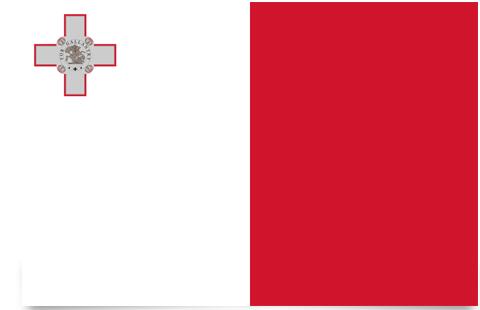Malta Flag and Meaning
Flag of Malta

Malta Flag Meaning
The coat of arms, which is located at the top of the innermost edge of the flag, shows with its heraldic elements from the Crusaders, the island’s great importance as a strategic key point during the Middle Ages. The flag is said to have originated from the conqueror of Malta; Roger I of Sicily in 1090. The cross was established in 1943 by George VI when the country was rewarded for its efforts during World War II with the St. George Cross award. Then the cross was instead against a blue background, but the blue color was removed with Malta’s independence in 1964. Their trade flag is completely red with a white Maltese cross that dates from the time when the Order of St. John ruled the island between the years 1530-1798.
Malta Overview
| Population | 400000 |
| Currency | Euro |
| Area | 320 km² |
| Capital city | Valleta |
| Population density | 1250 residents/km² |
| HDI location | 33 |
The country consists of 5 islands of which 2 are uninhabited. The inhabited islands are also the largest: Malta (where the capital is located) with 246 km² and Gozo with 67 km². The archipelago is located in the central Mediterranean south of Sicily, east of Tunisia and north of Libya. The high and rocky shores also contain coves that make up excellent natural harbors. The most serious environmental problems are concentrated in these areas and are mainly due to human expansion, tourism development, the gradual set-aside of agricultural land and the increasing discharge of wastewater and waste from industrial activity.
The people: The Maltese (95.7%) are descended from Phoenicians, Arabs, Italians and Englishmen. There is a small English minority (2.1%).
Religion: Catholicism (official religion). Minorities within the Anglican Church and Islam.
Languages: Maltese and English – both official. Maltese is a Semitic language with Italian elements and Latin alphabets.
Political parties: National Party, Labor Party, Democratic Alternative
Social Organizations: Confederation of Maltese Unions
Official name: Repubblika ta’Malta.
Capital: Valleta, 83,000 in (2003)
Other important cities: Birkirkara, 21,700 residents; Qormi, 18,100 residents; Sliema, 11,800 residents (2000).
Government: Parliamentary Republic. Marie Louise Coleiro Preca, President since April 2014. Joseph Muscat, Prime Minister since March 2013. The Parliament has one chamber of 65 members elected for a five-year term. The number of seats can be increased if a single party does not get an absolute majority in parliament.
National Day: September 21st. Independence Day (1964)
Armed Forces: 1,950 Soldiers (1996)













































